Brampton
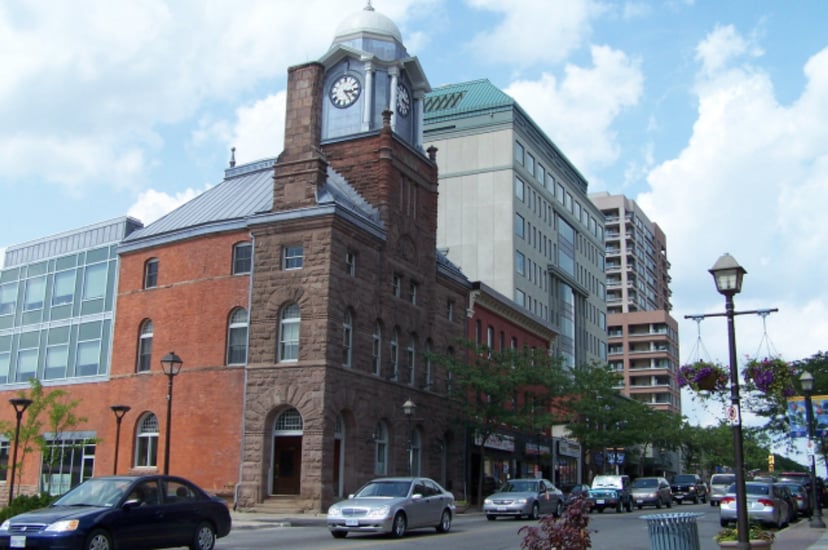
Brampton

| City of Brampton | |
| Nickname(s): | |
| Coordinates: | |
| Country | Canada |
|---|---|
| Province | Ontario |
| Region | Peel Region |
| Incorporation | 1853 (village) |
| 1873 (town) | |
| 1974 (city) | |
| Government | |
| •Mayor | Patrick Brown |
| • Governing Body | Brampton City Council(click for members) |
| •MPs | |
| •MPPs | |
| Area | |
| • Land | 266.71 km (102.98 sq mi) |
| Elevation | 218 m (715 ft) |
| Population | |
| • Total | 593,638 (9th) |
| • Density | 2,228.7/km (5,772/sq mi) |
| Demonym(s) | Bramptonian |
| Time zone | UTC−5(EST) |
| UTC−4(EDT) | |
| Forward sortation area | |
| Area code(s) | 905/289 |
| Website | www.brampton.ca[71] |
Brampton (/ˈbræmptən/ or /ˈbræmtən/) is a city in the Canadian province of Ontario. Situated in Southern Ontario, it is a suburban city in the Greater Toronto Area (GTA) and the seat of Peel Region. The city has a population of 593,638 as of the Canada 2016 Census. Brampton is Canada's ninth-most populous municipality, the seventy-seventh largest city in North America and the third most populous city in the Greater Golden Horseshoe Region, behind Toronto and Mississauga.[2]
Brampton was incorporated as a village in 1853 with 50 residents, taking its name from the market town of Brampton, in Cumbria, England. In 1873, with 2,000 residents, Brampton was incorporated as a town. The city was once known as "The Flower Town of Canada", a title based on its large greenhouse industry. Today, Brampton's major economic sectors include advanced manufacturing, retail administration, logistics, information, and communication technologies, food and beverage, life sciences, and business services. Mass immigration has greatly increased Brampton's population from 10,000 in the 1950s to over 600,000 today.
| City of Brampton | |
| Nickname(s): | |
| Coordinates: | |
| Country | Canada |
|---|---|
| Province | Ontario |
| Region | Peel Region |
| Incorporation | 1853 (village) |
| 1873 (town) | |
| 1974 (city) | |
| Government | |
| •Mayor | Patrick Brown |
| • Governing Body | Brampton City Council(click for members) |
| •MPs | |
| •MPPs | |
| Area | |
| • Land | 266.71 km (102.98 sq mi) |
| Elevation | 218 m (715 ft) |
| Population | |
| • Total | 593,638 (9th) |
| • Density | 2,228.7/km (5,772/sq mi) |
| Demonym(s) | Bramptonian |
| Time zone | UTC−5(EST) |
| UTC−4(EDT) | |
| Forward sortation area | |
| Area code(s) | 905/289 |
| Website | www.brampton.ca[71] |
History

John Haggert, Brampton's first mayor
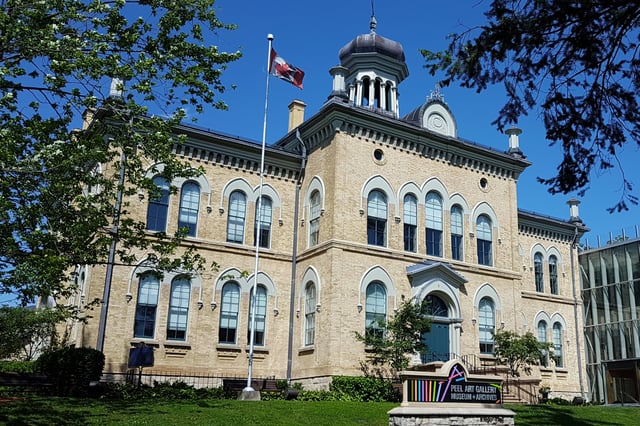
Now an art gallery, the former Peel County Court House was built in 1865–66

The Alderlea mansion, built c.1867-1870 for businessman Kenneth Chisholm
Prior to the 1800s, all real business in Chinguacousy Township took place at Martin Salisbury's tavern. One mile distant at the corner of Main and Queen streets, now the recognised centre of Brampton, William Buffy's tavern was the only significant building. At the time, the area was referred to as "Buffy's Corners". By 1834, John Elliott laid out the area in lots for sale, calling it "Brampton", which was soon adopted by others.[3]
In 1853, a small agricultural fair was set up by the newly initiated County Agricultural Society of the County of Peel, and was held at the corner of Main and Queen streets.
Grains, produce, roots, and dairy products were up for sale.
Horses and cattle, along with other lesser livestock, were also sold at market.
This agricultural fair eventually became the modern Brampton Fall Fair.
In that same year Brampton was incorporated as a village.[3] In 1866, the town became the county seat and the location of the Peel County Courthouse which was built in 1865-66; a three-storey County gaol was added at the rear in 1867.
Edward Dale, an immigrant from Dorking, England, established a flower nursery in Brampton[4] shortly after his arrival in 1863.[5] Dale's Nursery became the town's largest[4] and most prominent employer, developed a flower grading system,[5] and established a global export market for its products.[4] The company chimney was a town landmark,[5] until Brampton Town Council allowed it to be torn down in 1977.[5] At its height, the company had 140 greenhouses,[6] and was the largest cut flower business in North America,[7] producing 20 million blooms and introducing numerous rose and orchid varietals and species to the market.[7] It also spurred the development of other nurseries in the town. Forty-eight hothouse flower nurseries once did business in the town.[5][7]
A federal grant had enabled the village to found its first public library in 1887, which included 360 volumes from the Mechanic's Institute (est 1858). In 1907, the library received a grant from the Carnegie Foundation, set up by United States steel magnate and philanthropist Andrew Carnegie, to build a new, expanded library; it serves several purposes, featuring the Brampton Library. The Carnegie libraries were built on the basis of communities coming up with matching funds and guaranteeing maintenance.
In 1902, Sir William J. Gage (owner of Gage Publishing, a publishing house specializing in school text books) purchased a 3.25 acres (1.3 hectares) part of the gardens and lawns of the Alder Lea estate (now called Alderlea) that had been built on Main Street by Kenneth Chisolm in 1867 to 1870. (Chisholm, a merchant and founding father of Brampton, had been the Town reeve, then warden of Peel County, then MPP for Brampton and eventually, Registrar of Peel County.)[10] Sir William donated 1.7 acres (0.7 hectares) of the property to the town, with a specific condition that it be made into a park. Citizens donated $1,054 and the town used the funds to purchase extra land to ensure a larger park.[11][12]
A group of regional farmers in Brampton had trouble getting insurance from city-based companies.
After several meetings in Clairville Hall, they decided to found the County of Peel Farmers Mutual Fire Insurance Company.
In 1955, when the company moved to its third and current location, 103 Queen Street West, it took the new name of Peel Mutual Insurance Company.
It reigns as the longest-running company in modern Brampton.
Harmsworth Decorating Centre was established in 1890, as Harmsworth and Son, operated out of the family's house on Queen Street West.
The current location was purchased on September 1, 1904, after a fire destroyed their original store.
Purchased for $1,400, the 24 Main Street South location is the longest-operating retail business in what is now Brampton.
In 1974, the two townships of Chinguacousy and Toronto Gore were incorporated into Brampton.
The small pine added to the centre of the shield on the Brampton city flag represents Chinguacousy, honouring the Chippewa chief Shinguacose, "The Small Pine." After this merger, outlying communities such as Bramalea, Heart Lake and Professor's Lake, Snelgrove, Tullamore, and Mayfield, were developed.
In a revival of this theme, on 24 June 2002, the City Council established the "Flower City Strategy",[13][14] to promote a connection to its flower-growing heritage.[15] The intention was to inspire design projects and community landscaping to beautify the city, adopt a sustainable environmental approach, and to protect its natural and cultural heritage.[15] The Rose Theatre was named in keeping with this vision and is to serve as a cultural institution in the city.[5] In addition, the city participates in the national Communities in Bloom competition as part of that strategy.
The Old Shoe Factory, located on 57 Mill Street North, once housed the Hewetson Shoe Company.
It was listed as a historical property under the Ontario Heritage Act in 2008.
Today it is occupied by various small businesses.
The lobby and hallways retain details from 1907.
Walls are decorated with pictures and artifacts of local Brampton history and old shoe making equipment.[16]
A self-guided historical walking tour of downtown Brampton called "A Walk Through Time"[17] is available at Brampton City Hall and online free of cost.
Development of Bramalea
Developed as an innovative "new town", Bramalea was constructed approximately 40 kilometres northwest of Toronto. Located in the former Chinguacousy Township, it was Canada's first satellite community developed by one of the country's largest real estate developers, Bramalea Limited. The name "Bramalea" was created by the farmer William Sheard, who combined "BRAM" from Brampton, "MAL" from Malton (then a neighbouring town which is now part of the city of Mississauga), and "LEA", an Old English word meaning meadow or grassland. He sold the land to Brampton Leasing (the former name of the developer) and built one of Bramalea's first houses on Dixie Road.
The community was developed according to its detailed master plan, which included provisions for a parkland trail system and a "downtown" to include essential services and a shopping centre. The downtown's centrepiece was the Civic Centre, built in 1972 to include the city hall and library. Directly across Team Canada Drive, a shopping centre named Bramalea City Centre was built. These developments were connected by a long underground tunnel, planned to provide protection from winter weather. But, the tunnel has long since been closed due to safety issues. Urbanists have also found that pedestrians at street level make for much livelier and safer streets. Other features included a police station, fire hall, bus terminal, and a collection of seniors' retirement homes.
Each phase of the new city was marked with progressing first letters of street names. Development started with the "A" section, with street names such as Argyle, Avondale, and Aloma. Developers then created a "B" section, "C" section, and so forth. Children on the boundaries of these divisions would regularly compete in street hockey games, pitting, for example, the "D" section versus the "E" section.
The community was initially developed with a large number of recreational facilities, including tennis courts, playgrounds, hockey/lacrosse rinks and swimming pools.
An extensive parkland trail and sidewalk system connects the entire community.
Region of Peel
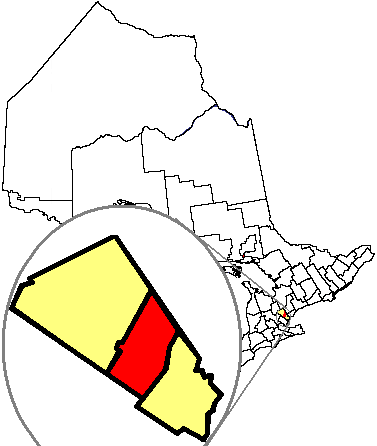
Brampton in the Region of Peel
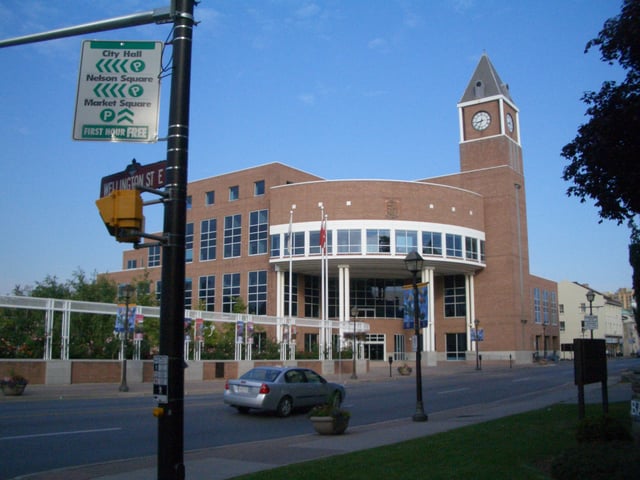
Brampton's City Hall
In 1974, the Ontario provincial government decided to update Peel County's structure. It amalgamated a series of villages into the City of Mississauga. In addition, it created the new City of Brampton from the greater portion of the Townships of Chinguacousy and Toronto Gore, including Bramalea and the other communities such as Claireville, Ebenezer, Victoria, Springbrook, Churchville, Coleraine, and Huttonville. While only Huttonville and Churchville still exist as identifiable communities, other names like Claireville are re-emerging as names of new developments.
The province converted Peel County into the Regional Municipality of Peel. Brampton retained its role as the administrative centre of Peel Region, which it already had as county seat. The regional council chamber, the Peel Regional Police force, the public health department, and the region's only major museum, the Peel Art Gallery, Museum and Archives, are all located in Brampton.
This change had its critics among those with a strong sense of local identities.
Bramptonians feared urban sprawl would dissolve their town's personality.
Bramalea residents took pride in the built-from-scratch and organised structure that had come with their new city and did not want to give it up.
Others in Bramalea accept they are part of Brampton, and they make up the tri-city area: Brampton, Heart Lake, Bramalea.
In 1972, Bramalea had built its civic centre.
Two years later, when Brampton and Bramalea merged, the new city's council chambers and other facilities were installed in the Bramalea building.
They were moved from Brampton's modest downtown locale.
The library systems of Brampton and Bramalea were joined, resulting in a system of four locations.
Some have questioned the future of Peel Region as encompassing all of Brampton, Mississauga, and Caledon. The Mississauga council, led by Mayor Hazel McCallion, voted to become a single-tier municipality and asked the provincial government to be separated from Peel Region. They argued the city has outgrown the need for a regional layer of government, and that Mississauga is being held back by supporting Brampton and Caledon with its municipal taxes.
Development as a city
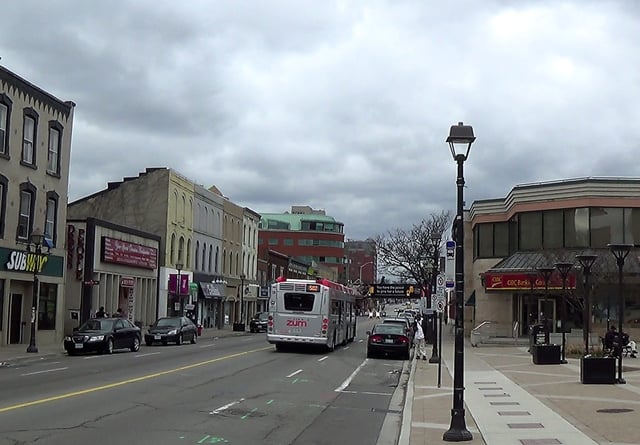
Main Street in downtown Brampton
The early 1980s brought new residential development, as Brampton released large tracts of land to developers.
In 1995 the large new suburban community of Springdale was developed, contributing to what people consider urban sprawl.
This area had its largest boom in 1999, when development started to appear as far north as the city's border with Caledon. The region has designated this border as the line of demarcation for urban development until 2021. Neighbouring communities not part of Peel Region have also been dramatically affected by the city's sudden spurt. Part of the boundary between Brampton and Vaughan, for example, is nearly completely urbanized.
In the early 1980s, Cineplex Odeon closed the Capitol Theatre in Brampton. The City bought the facility in 1981 under the leadership of councillor Diane Sutter. It adapted the former vaudeville venue and movie house as a performing arts theatre, to be used also as a live music venue. It was renamed the Heritage Theatre. Renovations and maintenance were expensive. In 1983, Toronto consultants Woods Gordon reported to the City that, rather than continue "pouring money" into the Heritage, they should construct a new 750-seat facility with up-to-date features. This recommendation was adopted, and the city designated the 2005/06 as the Heritage Theatre's "grand finale" season. The city funded construction of the new Rose Theatre, which opened in September 2006.
Carabram was founded in 1984, the result of volunteers from different ethnic communities wanting to organise a festival celebrating diversity and cross-cultural friendship. The name was loosely related to Toronto's Caravan Festival of Cultures. Carabram's first event featured Italian, Scots, Ukrainian, and West Indian pavilions. By 2003, the fair had 18 pavilions attracting 45,000 visitors. The national government of Canada had an anchor pavilion in the late 1980s and early 1990s, and for Carabram's 25th Anniversary in 2009.
Brampton has grown to become one of the most diverse cities in Canada.
In 1996, the city was 13% South Asian and 8.2% Black.[18] By 2016, the South Asian community grew exponentially to represent 44.3% of the city's population, while the Black population grew to 14%.[19] Responding to a growing multi-cultural population, the Peel Board of Education introduced evening English as a Second Language (ESL) classes at high schools. Originally taught by volunteers, the classes eventually were scheduled as daytime courses taught by paid instructors. In the 1980s, the public and Catholic board expanded its languages programs, offering night classes in 23 languages. These were introduced due to requests by parents, who wanted their children to learn their ancestral languages and heritage.
In the early 1990s, Mayor Ken Whillans gained approval and funding for construction of a new city hall in Brampton's downtown.
The facility was designed by local architects and constructed by Inzola Construction.
Whillians did not get to see the opening of the new hall because of his death in August of that same year.
With the return of city government to downtown Brampton, politicians and businesses allied to revitalize the core.
Changes continue to reflect the growth of the city.
In 1992 the City purchased the Brampton Fairgrounds, to be used for other development.
The Agricultural Society relocated in 1997 outside the boundaries of the city to Heart Lake and Old School roads.
In 1997 the Health Services Restructuring Commission (HSRC) decided to amalgamate Georgetown and District Memorial Hospital, Etobicoke General Hospital, and Peel Memorial Hospital as the William Osler Health Centre. It became what is now the province's 6th-largest hospital corporation.
Brampton's 2003 Sesquicentennial celebrations boosted community spirit, reviving the tradition of a summer parade (with 100 floats), and creating other initiatives.
To commemorate the town's history, the city under Mayor Fennell reintroduced floral projects to the community.
These have included more plantings around town, the revival in 2005 of the city Parade, and participation in the Canada Communities in Bloom project.
Geography and climate
Brampton has a total land area of 265 square kilometres (102 sq mi). The City of Brampton is bordered by Highway 50 (Vaughan) to the East, Winston Churchill Boulevard (Halton Hills) to the West, Mayfield Road (Caledon) to the north (except for a small neighbourhood, Snelgrove, which is part of Brampton despite extending somewhat north of Mayfield Road) and the hydro corridor (Mississauga) to the south except at Finch Avenue (at this point, Finch Avenue serves as the border between the two cities).
Brampton features a continental climate (Köppen climate classification Dfb) which is typical to much of Peel Region and the rest of the Greater Toronto Area.
| Climate data forLester B. Pearson International Airport1981–2010 (Brampton and North Mississauga) | |||||||||||||
|---|---|---|---|---|---|---|---|---|---|---|---|---|---|
| Month | Jan | Feb | Mar | Apr | May | Jun | Jul | Aug | Sep | Oct | Nov | Dec | Year |
| Record highhumidex | 19.0 | 14.8 | 29.2 | 37.9 | 42.6 | 45.0 | 50.3 | 46.6 | 48.0 | 39.1 | 28.6 | 23.9 | 50.3 |
| Record high °C (°F) | 17.6(63.7) | 17.7(63.9) | 26.0(78.8) | 31.1(88.0) | 34.4(93.9) | 36.7(98.1) | 37.6(99.7) | 38.3(100.9) | 36.7(98.1) | 31.6(88.9) | 25.0(77.0) | 20.0(68.0) | 38.3(100.9) |
| Average high °C (°F) | −1.5(29.3) | −0.4(31.3) | 4.6(40.3) | 12.2(54.0) | 18.8(65.8) | 24.2(75.6) | 27.1(80.8) | 26.0(78.8) | 21.6(70.9) | 14.3(57.7) | 7.6(45.7) | 1.4(34.5) | 13.0(55.4) |
| Daily mean °C (°F) | −5.5(22.1) | −4.5(23.9) | 0.1(32.2) | 7.1(44.8) | 13.1(55.6) | 18.6(65.5) | 21.5(70.7) | 20.6(69.1) | 16.2(61.2) | 9.5(49.1) | 3.7(38.7) | −2.2(28.0) | 8.2(46.8) |
| Average low °C (°F) | −9.4(15.1) | −8.7(16.3) | −4.5(23.9) | 1.9(35.4) | 7.4(45.3) | 13.0(55.4) | 15.8(60.4) | 15.1(59.2) | 10.8(51.4) | 4.6(40.3) | −0.2(31.6) | −5.8(21.6) | 3.3(37.9) |
| Record low °C (°F) | −31.3(−24.3) | −31.1(−24.0) | −28.9(−20.0) | −17.2(1.0) | −5.6(21.9) | 0.6(33.1) | 3.9(39.0) | 1.1(34.0) | −3.9(25.0) | −8.3(17.1) | −18.3(−0.9) | −31.1(−24.0) | −31.3(−24.3) |
| Record lowwind chill | −44.7 | −38.9 | −36.2 | −25.4 | −9.5 | 0.0 | 0.0 | 0.0 | −8.0 | −13.5 | −25.4 | −38.5 | −44.7 |
| Averageprecipitationmm (inches) | 51.8(2.04) | 47.7(1.88) | 49.8(1.96) | 68.5(2.70) | 74.3(2.93) | 71.5(2.81) | 75.7(2.98) | 78.1(3.07) | 74.5(2.93) | 61.1(2.41) | 75.1(2.96) | 57.9(2.28) | 785.9(30.94) |
| Average rainfall mm (inches) | 25.1(0.99) | 24.3(0.96) | 32.6(1.28) | 63.0(2.48) | 74.3(2.93) | 71.5(2.81) | 75.7(2.98) | 78.1(3.07) | 74.5(2.93) | 60.6(2.39) | 68.0(2.68) | 34.0(1.34) | 681.6(26.83) |
| Average snowfall cm (inches) | 29.5(11.6) | 24.0(9.4) | 17.7(7.0) | 4.5(1.8) | 0.02(0.01) | 0.0(0.0) | 0.0(0.0) | 0.0(0.0) | 0.0(0.0) | 0.4(0.2) | 7.5(3.0) | 24.9(9.8) | 108.5(42.7) |
| Average precipitation days(≥ 0.2 mm) | 15.1 | 11.6 | 12.4 | 12.5 | 12.5 | 10.8 | 10.4 | 10.2 | 10.5 | 12.1 | 13.2 | 14.8 | 145.9 |
| Average rainy days(≥ 0.2 mm) | 5.4 | 4.6 | 7.4 | 11.3 | 12.5 | 10.8 | 10.4 | 10.2 | 10.5 | 12.0 | 11.0 | 7.1 | 113.2 |
| Average snowy days(≥ 0.2 cm) | 12.1 | 9.4 | 6.8 | 2.4 | 0.03 | 0.0 | 0.0 | 0.0 | 0.0 | 0.3 | 3.4 | 10.0 | 44.4 |
| Averagerelative humidity(%)(at 15:00) | 72.0 | 68.4 | 61.4 | 54.4 | 53.5 | 54.9 | 53.3 | 55.8 | 58.5 | 62.1 | 69.2 | 72.5 | 61.3 |
| Mean monthlysunshine hours | 79.7 | 112.2 | 159.4 | 204.4 | 228.2 | 249.7 | 294.4 | 274.5 | 215.7 | 163.7 | 94.2 | 86.2 | 2,161.4 |
| Percentpossible sunshine | 27.6 | 38.0 | 43.2 | 50.8 | 50.1 | 54.1 | 63.0 | 63.4 | 57.4 | 47.8 | 32.0 | 30.9 | 46.5 |
| Source: Environment Canada[20][22][23] | |||||||||||||
Demographics
| Historical populations | ||
|---|---|---|
| Year | Pop. | ±% |
| 1858 | 50 | — |
| 1871 | 2,090 | +4080.0% |
| 1881 | 2,920 | +39.7% |
| 1891 | 3,252 | +11.4% |
| 1901 | 2,748 | −15.5% |
| 1911 | 3,412 | +24.2% |
| 1921 | 4,527 | +32.7% |
| 1931 | 5,532 | +22.2% |
| 1941 | 5,975 | +8.0% |
| 1951 | 8,389 | +40.4% |
| 1961 | 18,467 | +120.1% |
| 1971 | 41,211 | +123.2% |
| 1981 | 149,030 | +261.6% |
| 1991 | 234,445 | +57.3% |
| 1996 | 268,251 | +14.4% |
| 2001 | 325,428 | +21.3% |
| 2006 | 433,806 | +33.3% |
| 2011 | 523,906 | +20.8% |
| 2016 | 593,638 | +13.3% |
| Brampton annexed Chinguacousy Township—including the highly populated communities of Bramalea and Heart Lake—in 1974.The2011 population count was revised in 2016.[2] | ||
| Visible minority and Aboriginal population (Canada 2016 Census) | |||
|---|---|---|---|
| Population group | Population | % of total population | |
| South Asian | 261,705 | 44.3% | |
| Black | 82,175 | 13.9% | |
| Filipino | 20,100 | 3.4% | |
| Latin American | 14,045 | 2.4% | |
| Southeast Asian | 8,425 | 1.4% | |
| Chinese | 8,955 | 1.5% | |
| West Asian | 5,275 | 0.9% | |
| Japanese | 530 | 0.1% | |
| Korean | 430 | 0.1% | |
| Other Visible Minority | 15,950 | 2.7% | |
| Multiple visible minority | 9,585 | 1.6% | |
| Total visible minority population | 433,230 | **73.3%** | |
| Aboriginalgroup[24] | First Nations | 2,630 | 0.4% |
| Métis | 1,255 | 0.2% | |
| Inuit | 100 | 0% | |
| Aboriginal, n.i.e. | 160 | 0% | |
| Multiple Aboriginal identity | 180 | 0% | |
| Total Aboriginal population | 4,330 | **0.7%** | |
| European | 153,390 | 26% | |
| Total population | 590,950 | 100% | |
According to the 2016 census, the most common ethnicities in Brampton are East Indian (33.4%), Canadian (10.8%), Jamaican (7.8%), English (7.4%), Irish (5.3%), Scottish (5.1%), Punjabi (5.0%), Italian (4.3%), Portuguese (4.1%), and Filipino (3.7%).[30]
Religion
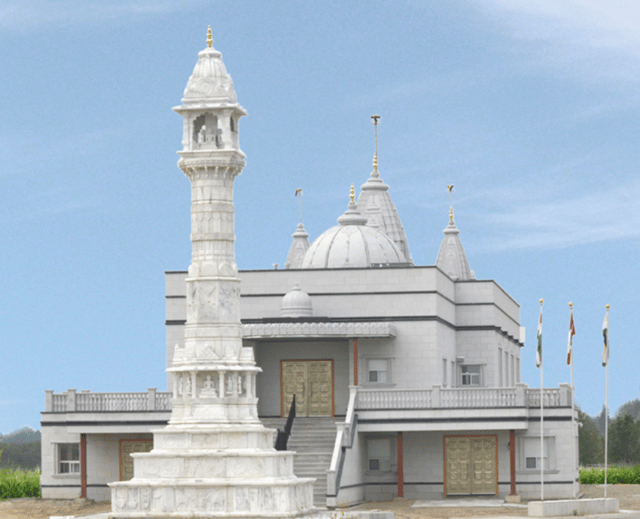
Brampton Jain Temple in Brampton, Ontario
Proportionally, Brampton has the second largest Sikh population among Canadian cities. Some 50.5 percent of Brampton's population still identify with various Christian denominations. The largest was Catholicism (26.0%), followed by various Protestant denominations, including Anglican, United Church, Lutheran, Baptist, and Reformed Church, while the remaining numbers of Christians consists mostly of Eastern Orthodox Churches. Other religions with a notable presence include Sikhism (18.8%), Hinduism (12.1%), and Islam (7.1%). Nearly 10 percent of the population does not identify with a particular religion.[24] The Toronto Ontario Temple for The Church of Jesus Christ of Latter-day Saints (LDS Church) is located in Brampton.[31]
Population growth
With a population of 593,638,[2] Brampton is the third-largest city in the Greater Toronto Area, and the ninth-largest city in Canada. With the median age at 33.7, it is the youngest community in the GTA.
Brampton has attracted residents and businesses due to its proximity to the Pearson International Airport and road infrastructure, population growth, cost of land, and more favourable corporate tax structure. It is becoming a prime location for corporate head offices, factories, warehouses, etc., as well as the typical domestic goods and services required to provide for the population.
Languages
The 2011 census found that English was spoken as primary language by 51.71% of the population. The next most common language was Punjabi, spoken by 17.51% of the population, followed by Urdu at 2.79%, and Portuguese and Gujarati at 2.12% each.[32]
| Mother tongue | Population | Percentage |
|---|---|---|
| English | 269,790 | 51.71% |
| Punjabi | 91,345 | 17.51% |
| Urdu | 14,580 | 2.79% |
| Portuguese | 11,095 | 2.12% |
| Gujarati | 11,040 | 2.12% |
| Spanish | 10,225 | 1.96% |
| Hindi | 10,060 | 1.93% |
| Tamil | 9,530 | 1.83% |
| Tagalog (Filipino) | 8,785 | 1.68% |
| Italian | 7,990 | 1.53% |
Economy
Companies with headquarters in Brampton include Loblaw Companies Ltd. and Rogers Communications Inc.,[33] Chrysler Canada Brampton Assembly Plant,[34] Maple Lodge Farms,[33] Canadian Tire Corp,[33] Coca-Cola Bottling Company Ltd.,[33] Gamma-Dynacare Medical Laboratories,[35] and Olymel L.P,[33] and formerly Zellers (offices and distribution).[36]
The international companies of Brita, and Clorox have their Canadian national headquarters in the city. It is also the location of the Canadian Forces Army Reserve unit The Lorne Scots (Peel, Dufferin and Halton Regiment).[37]
An automobile manufacturing facility was opened by American Motors (AMC) in 1960 as the Brampton Assembly Plant. In 1986, AMC developed a new, state-of-the-art operation at Bramalea. After AMC was acquired by Chrysler in 1987, AMC's Canadian division and its plants were absorbed; the older facility in Brampton closed in 1992. The newest factory was renamed Brampton Assembly; it is one of the city's largest employers, with almost 4,000 workers when running at capacity.[46]
Education
Brampton's only public higher education institution is the Davis campus of Sheridan College, which also has a campus in Oakville. In 2017, Davis added the Skilled Trades Centre, for training in skilled trades and apprenticeship programs, previously offered in Oakville.[47]
The Algoma University @ Brampton School of Business & Economics offers courses at Market Square Business Centre, 24 Queen Street East. [48] The closest universities to Brampton (offering a wider range of programs) include York University in north Toronto and University of Toronto Mississauga.
A plan by Ryerson University, in partnership with Sheridan College was to establish a new campus in Brampton with a goal of opening in 2022 with $90 million in funding offered by the provincial government in April 2018.[49][50] On 23 October 2018 however, the new Provincial government (elected in June) withdrew the funding for plans such as this, effectively cancelling the project.[51]
Two main school boards operate in Brampton: the Peel District School Board, which operates secular anglophone public schools, and Dufferin-Peel Catholic District School Board, which operates Catholic anglophone public schools. Under the Peel District School Board, the secondary schools are Bramalea, Brampton Centennial, Central Peel, Chinguacousy, Fletcher's Meadow, Harold M. Brathwaite, Heart Lake, Louise Arbour, Mayfield, North Park, Judith Nyman, Sandalwood Heights, Turner Fenton, David Suzuki, Castlebrooke Secondary School, and Jean Augustine, one of the newest. A total of 85 elementary and middle schools feed these high schools in the city.
Under the Dufferin-Peel Catholic District School Board, the secondary schools are Cardinal Leger, Holy Name of Mary, Notre Dame, St. Augustine, St. Edmund Campion, St. Roch, St. Marguerite d'Youville, St. Thomas Aquinas, and Cardinal Ambrozic. A total of 44 Catholic elementary and middle schools feed these high schools in the city.
The Conseil scolaire Viamonde operates secular Francophone schools serving the area. The Conseil scolaire catholique MonAvenir
Culture
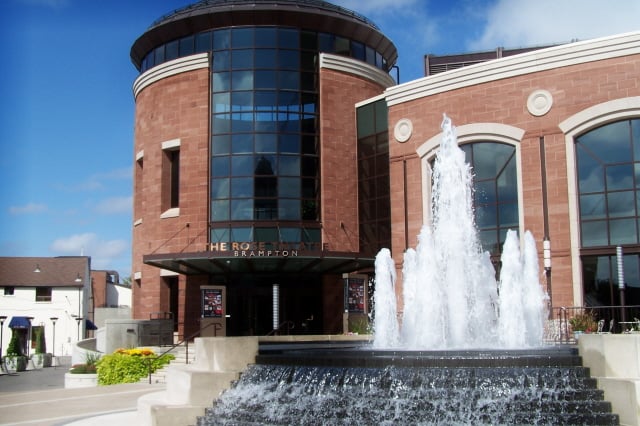
The Rose Theatre Fountain Stage

LCD video screen at Garden Square, downtown

A Peel Art Gallery, Museum, Archives building, formerly the Peel County Court House
Several cultural entities in the city operate under the umbrella of the Brampton Arts Council. Located in the city is the Peel Art Gallery, Museum and Archives (PAMA, formerly the Peel Heritage Complex), which is run by the Region of Peel.[52]
The Rose Theatre (originally the Brampton Performing Arts Centre), opened in September 2006. The City had expected the facility to generate $2.7 million in economic activity the first year, growing to $19.8 million by the fifth year. The Rose Theatre far surpassed projections, attracting more than 137,000 patrons in its inaugural year, which exceeded its five-year goal. The arrival of so many new patrons downtown has stimulated the development of numerous new businesses nearby. A new Fountain Stage was unveiled in June 2008 at the nearby Garden Square.
Brampton has six library locations to serve its half-million residents.
With a ratio of one library per more than 80,000 residents, it has the lowest library ratio among major Canadian cities.
The Peel Art Gallery, Museum and Archives (PAMA) in Brampton includes a museum, art gallery, and archives. Since opening in 1968, the art gallery section (previously known as the Art Gallery of Peel) has exhibited local, national, and international artists, both contemporary and historical from their permanent collection.
The City of Brampton's long-standing heritage conservation program [74] was recognised with the 2011 Lieutenant Governor's Ontario Heritage Award for Community Leadership.
In 2010 the City received an 'honourable mention' under the same provincial awards program.
Sites of interest
Gage Park
Artway Gallery
Beaux Arts Brampton
CAA Centre
Camp Naivelt
Chinguacousy Park-Greenhouse and gardens
Mount Chinguacousy[53]
Claireville Conservation Area
Flower City Theatre Festival
Great War Flying Museum
Heart Lake Conservation Area
Brampton Historical Society[54]
Historic Bovaird House[55]
Korean War Memorial Wall (Canada)
Ontario Field of Honour
Peel Art Gallery, Museum and Archives
Professor's Lake
Rose Theatre[56]
Lester B. Pearson Theatre[57]
South Fletchers Sportsplex
Wet'n'Wild Toronto
Major shopping areas include Bramalea City Centre, Shoppers World, and "big box centre" Trinity Commons. The downtown area has some retail; the Centennial Mall and the Brampton Mall are also of note.
Media
Brampton was one of the first areas where Rogers Cable offered its service. The city started a community access channel in the 1970s, which still operates. While some programs on the channel are produced in its Brampton studios, most are based in its Mississauga location. Christian specialty channel Vertical TV is based in Brampton.
The Brampton Guardian is the community's only newspaper. The city's first newspaper, The Daily Times, stopped circulation in the early 1980s. For a little over a year, The Brampton Bulletin attempted to challenge the Guardian, but it was dismantled after a series of editor changes.
Brampton is the official city of license for two radio stations, CIAO and CFNY. Both stations address their programming toward the entire Greater Toronto Area rather than exclusively to Brampton.
Sports and recreation
| Club | League | Sport | Venue | Established | Disestablished | Championships |
|---|---|---|---|---|---|---|
| Brampton A's | National Basketball League of Canada | Basketball | Powerade Centre | 2013 | 2015 | 0 |
| Brampton Admirals | Ontario Junior Hockey League | Hockey | Brampton Memorial Arena | 2018 | 0 | |
| Brampton Battalion | OHL | Hockey | Powerade Centre | 1998 | 2013 | 0 |
| Brampton Bears | Northern Football Conference | Football | 1985 | 1995 | ||
| Brampton Beavers | Marshall Premiership | Rugby | "The Beaver Dam" at MGS Sports Park | 1963 | ||
| Brampton Beast | ECHL | Hockey | CAA Centre | 2013 | 0 | |
| Bramalea Blues | Ontario Provincial Junior A Hockey League | Hockey | Powerade Centre | 1972 | 2010 | 1 |
| Brampton Bombers | Greater Ontario Junior Hockey League | Hockey | Brampton Memorial Arena | 2012 | 0 | |
| Brampton Thunder | Canadian Women's Hockey League | Hockey | Powerade Centre | 1999 | 2017 | 0 |
| Brampton Capitals | Ontario Provincial Junior A Hockey League | Hockey | Brampton Memorial Arena | 1984 | 2012 | 4 |
| Brampton Excelsiors | Major Series LacrosseSenior "A" Lacrosse League. | Box Lacrosse | CAA Centre | 1912 | 30 | |
| Junior Excelsiors | OLA Junior A Lacrosse League | Box Lacrosse | Brampton Memorial Arena | 1971 | 4 | |
| Junior "b" Excelsiors | OLA Junior B Lacrosse League | Box Lacrosse | Victoria Park Arena | 2012 | 0 | |
| Brampton Royals | Central Ontario Baseball Assoc. | Baseball | Dave Dash Memorial Field | 1948 | 3 | |
| Brampton Senior Royals | Central Ontario Major Baseball Assoc. | Baseball | Dave Dash Memorial Field | 2004 | 0 | |
| Bramalea Satellites | Northern Football Conference | Football | 1974 | 1975 | ||
| Brampton UnitedFC | Canadian Soccer League, National Division | Soccer | Victoria Park Stadium | 2002 | 1 |
Brampton is home to one professional sports franchise, the Brampton Beast of the ECHL, which plays at the CAA Centre, formerly the Powerade Centre. From 2013 to 2015, the Powerade Center was also the home of the Brampton A's in the National Basketball League of Canada, however, they relocated to Orangeville, Ontario, to decrease costs of operations of switching the arena floor from ice hockey to basketball.
The numerous sporting venues and activities includes the outdoor ice path for skating through Gage Park. Chinguacousy Park includes a ski lift, a curling club, and Tennis Centre for multi-season activities. In the summer, amateur softball leagues abound. Crowds line the beaches at Professor's Lake for the annual outdoor "shagging" display.
Every year since 1967, the Brampton Canadettes have hosted the Brampton Canadettes Easter Tournament in hockey.[58] Women's and girls' hockey teams invade Brampton for 3½ days of head-to-head competition. Teams of all ages and categories from across Canada and the United States compete in this annual tournament. Teams from England, Switzerland, Japan, Kazakhstan and Russia attend this international tournament. Thousands of players and spectators pass through the doors during the tournament. There is no limit on the number of teams in a division.
The Intermediate AA and Midget AA divisions are highly scouted by local and United States colleges and universities seeking recruits for varsity teams.
Teams from as far as Alaska and Calgary, Quebec and Carolina, Michigan and Minnesota, as well as virtually all hockey centres in Ontario, will compete in a minimum of 3 games each over the course of the tournament.
Including championship finals, over 600 games are played in 3½ days.
Infrastructure
Health and medicine
Courts
Grenville & William Davis Courthouse, Ontario Court of Justice, is located in Brampton at 7755 Hurontario Street (Hurontario Street at County Court).
Transportation
Public transit
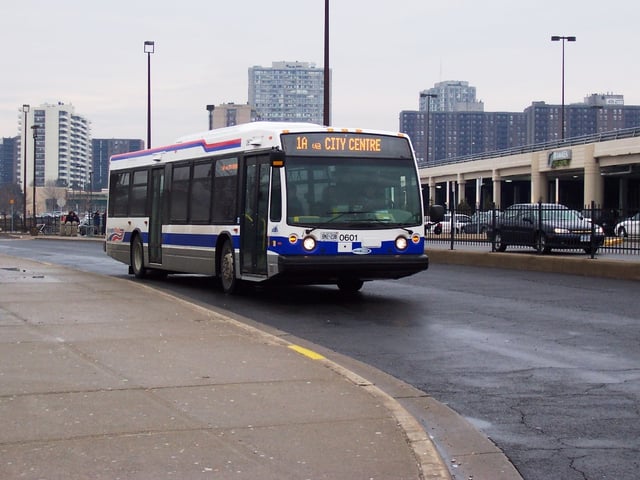
Brampton Transit bus at the now-relocated Bramalea City Centre Terminal
Local transit is provided by Brampton Transit, with connections to other systems such as MiWay, York Region Transit, Go Transit, and Toronto Transit Commission. Brampton also has a new Bus Rapid Transit system, "Züm" (pronounced Zoom), previously known as AcceleRide along Main/Hurontario Streets, Steeles Avenue and Queen Street/Highway, Bovaird Dr & Airport Rd & Queen Street West & Mississauga Road.
7, which would form the backbone to its bus network. Züm received funding from the provincial government in 2006 to begin implementation of this system. The cash fare is $4.00 for single adult transfer, which is valid for 2 hours.
There is GO Bus service to York University and subway stations at Yorkdale Mall and York Mills in Toronto. There are three GO Train stations in Brampton: Bramalea, Brampton and Mount Pleasant.
Rail
Both Canadian National Railways and the Orangeville-Brampton Railway short line (formerly part of the Canadian Pacific Railway line) run through the city. CN's Intermodal Yards are located east of Airport Road between Steeles and Queen Street East. The CN Track from Toronto's Union Station, is the Kitchener GO Transit Rail Corridor providing commuter rail and bus services to and from Toronto with rail station stops at Bramalea, Downtown Brampton, and Mount Pleasant. Via Rail connects through Brampton as part of the Quebec City-Windsor Corridor.
Air
Canada's busiest airport, Toronto Pearson International Airport (CYYZ), is located near Brampton, in Mississauga.[59] For general aviation, the city is served by the privately owned Brampton Airport (CNC3), located to the north of the city in neighbouring Caledon.
Road
Brampton is served by several major transportation routes: Highway 401 from Toronto is a short distance south in Mississauga, and can be reached by Highway 410, which runs north-south through the middle of the city. Highway 407 runs along the southern portion of the city, just north of the boundary with Mississauga. Steeles Avenue, which runs north of the 407, is another thoroughfare from Toronto. Main Street, a part of the historic road, Hurontario Street, and formerly Highway 10, is the city's main north-south artery. The former Highway 7, (now Regional Road 107) is another east-west corridor, incorporates the eastern part of Queen Street (which is the city's main east-west street) and the western part of Bovaird Drive.
Representation in other media
Deepa Mehta's 2008 film Heaven on Earth is set in Brampton.[60]
Notable Bramptonians
Four people from Brampton have received the Order of Canada: Robert William Bradford, former Director of the National Aviation Museum; Michael F. Clarke, director at Evergreen, the Yonge Street Mission for street youth in Toronto; Howard Pawley, professor and former Premier of Manitoba; and William G. Davis, former Premier of Ontario.
Sports

Rick Nash in 2006, playing for the Columbus Blue Jackets
Basketball: Michael Meeks (internationally), Tyler Ennis (NBA), Tristan Thompson (NBA), Anthony Bennett (NBA)
Cricket: Saad Bin Zafar, Cecil Pervez,
Curling: Scott Bailey, Peter Corner, Graeme McCarrel, Wayne Middaugh, Allison Pottinger
Field hockey: Bernadette Bowyer
Figure skating: Vern Taylor, Mark Janoschak
Football: Michael Bailey (CFL), Fernand Kashama (CFL), Chris Kowalczuk (CFL), Rob Maver (CFL), Jerome Messam (CFL, NFL), Jason Nugent (CFL), Junior Turner (CFL), Steven Turner (CFL), Jabar Westerman (CFL), Jamaal Westerman (NFL), James Yurichuk (CFL)[61] Nakas Onyeka (CFL)
Golf: David Hearn; Steve Duplantis (caddy)
Hockey: Andrew Cassels, Mike Danton, Mike Dwyer, Todd Elik, Chris Felix, Sheldon Keefe, Tom Laidlaw, Kris Newbury, Rick Nash, Tyler Seguin, Jamie Storr, Mike Weaver, Mike Wilson, Sean Monahan, Tyler Graovac, Cassie Campbell
Horse-racing: Sid C. Attard, Patrick Husbands, Robert P. Tiller, Emma-Jayne Wilson
Lacrosse: Jim Veltman (NLL)
Sailing: Kevin Stittle
Soccer: Gabe Gala (MLS), Atiba Hutchinson (Super Lig), Peter Roe (ASL, MISL), Murphy Wiredu, Doniel Henry, David "Junior" Hoilett, Paul Stalteri, Roger Thompson, Cyle Larin
Speed skating: Tyson Heung
Tennis: Jill Hetherington, Milos Raonic
Track and field: Charles Allen, Mark Boswell
Wrestling: Ohenewa Akuffo
Politics
Three Canadian premiers got their start in Brampton; Premiers Tobias Norris and Howard Pawley OC of Manitoba, and "Brampton Billy", Ontario premier William Grenville Davis CC. Other notable politicians include John Coyne, and Conservative opposition leader Gordon Graydon. Alberta politician and businessman Sir James A. Lougheed was born in Brampton, and served 30 years in Senate; Regina mayor David Lynch Scott was born here.
President of the Treasury Board Tony Clement spent time as a Brampton MPP. John McDermid held various cabinet positions under Brian Mulroney, Bal Gosal Minister of State-Sport, and former Mayor Linda Jeffrey held cabinet positions at the provincial level.
Ruby Dhalla represented the riding of Brampton—Springdale in the Canadian House of Commons from 2004-2011 as a member of the Liberal Party. Dhalla and British Columbia Conservative MP Nina Grewal were the first Sikh women to serve in the Canadian House of Commons. Parm Gill was elected as the member of parliament from the Conservative Party of Canada for the riding of Brampton-Springdale in 2011, who was also appointed as the Parliamentary Secretary to the Minister of Veteran Affairs in 2013.
Arts
Authors born in or living in Brampton include Rohinton Mistry and Edo Van Belkom.
Visual arts notables from Brampton include Curtis Albert Williamson, co-founder of the Canadian Art Club (1907),[62] etcher Caroline Helena Armington,[63] Ronald Bloore, Member of the Order of Canada; Organiser and member of the "Regina Five",(1960)[64] watercolourist Jack Reid, and William Ronald, who was raised in town. Norman Mills Price. Animators David Feiss and Jay Stephens grew up here.
Music acts from Brampton include Punk band The Flatliners, R&B singer Keshia Chanté, country singer Johnny Reid, "Metal Queen" Lee Aaron, pop singer Alyssa Reid, and rapper D-Pryde. Country singer and "World Champion Yodeler" Donn Reynolds lived here from 1969 to 1997.[65] Barry Stock, guitarist from Three Days Grace was raised in Brampton, and currently resides in Caledon. Singer Alessia Cara, hip-hop artist Roy Woods and singer / rapper Tory Lanez were also born in Brampton.
Film, television and comedy

Comedian Russell Peters
Two notable comedians hail from Brampton, Scott Thompson and Russell Peters.
Comedic actor Michael Cera was born and raised in Brampton. Shawn Ashmore, Aaron Ashmore (Smallville) are Brampton-raised. Tyler Labine locally raised actor is currently the star of (Mad Love
Other Brampton-born or affiliated actors include Paulo Costanzo, Jordan Gavaris, Gemini Award winner Kris Lemche, Lara Jean Chorostecki, Sabrina Grdevich, Nicole Lyn, Dulé Hill, actor and producer David J. Phillips, reality TV star and art dealer Billy Jamieson, and three time Academy Award nominee George R. Robertson.
Of those best known as voice actors, Brenna O'Brien (InuYasha, Zixx: Level Two). On-air media personalities Cassie Campbell, Chris Connor, Chris Cuthbert and Scott McGillivray have connections to the town.
See also
Brampton Board of Trade
Brampton municipal election, 2006
City of Brampton Arts Person of the Year
List of airports in the Greater Toronto Area
List of historic places in Brampton